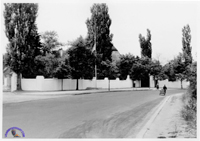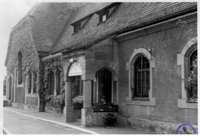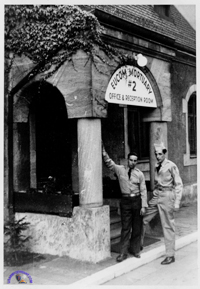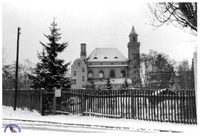| If you do
NOT see the Table of Contents frame to the left of this page, then
Click here to open 'USArmyGermany' frameset |
||||||||||||||||||||||||||||
|
Quartermaster Division |
||||||||||||||||||||||||||||
|
|
||||||||||||||||||||||||||||
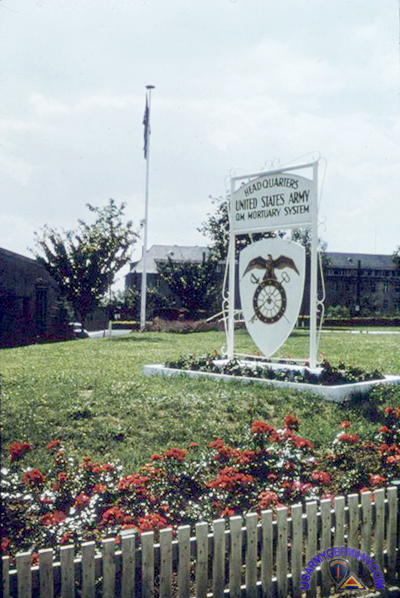 Hqs US Army QM Mortuary System Sign in Frankfurt |
||||||||||||||||||||||||||||
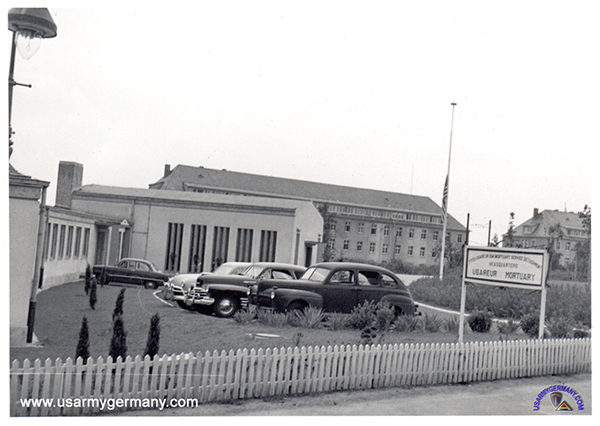 Headquarters US Army QM Mortuary System, Frankfurt, early 1950s |
||||||||||||||||||||||||||||
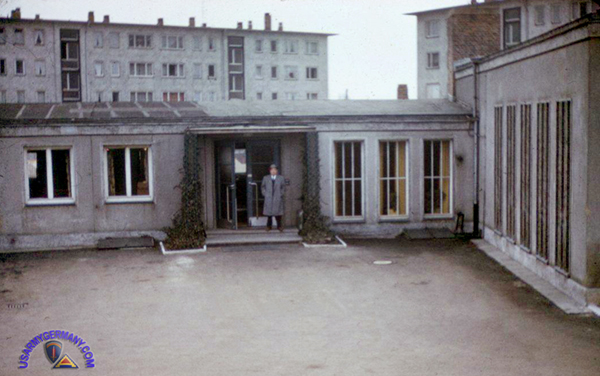 Entrance to US Army QM Mortuary System in Frankfurt, 1950s |
||||||||||||||||||||||||||||
| (Source: Quartermaster PB, Winter 2002) Mortuary Affairs Operations in Europe David B. Roath The US Army Mortuary System Europe was established 29 September 1947, with the activation of the 7770th European Quartermaster Mortuary Service. The Quartermaster Mortuary Service was located in the German Municipal Cemetery, Frankfurt, Germany, and assigned to the Headquarters European Command. The newly formed unit operated mortuaries in Munich, Nurnberg Bremerhaven, La Chapelle and Frankfurt. Recovered remains were evacuated by surface transportation through the port of Bremerhaven, Germany, until 1955. The mission of the 7770th was to recover remains from World War II and World War I and process the remains of service members and dependents who died while serving on an overseas assignment in the United States’ European, Mediterranean and Africa-Middle East areas of responsibility. The unit was actively engaged in the recovery of World War II remains for identification and burial overseas in permanent military cemeteries or return to the United States for burials in federal, state and private cemeteries. The Return of Remains Program officially ended on 31 December 1951. All search and recovery mission responsibilities for residual remains recovered after that date were assigned to the theater commander. Remains of World War I and World War II service members recovered after 1951 became the responsibility of the theater commander who directed this task to the US Army Mortuary System Europe - now called the United States Army Memorial Affairs Activity Europe (USAMAA-E) in Landstuhl, Germany.
European Mortuary Operations, 1950s In 1953, a new mortuary was constructed near Kaiserslautern, Germany, and first used in July 1953. In 1955, all evacuations from the theater changed from surface transportation to air evacuation by military aircraft at various airbases in the European Theater. In March 1957, the unit reorganized as the US Army Quartermaster Mortuary System, Europe, with assignment to the Headquarters US Army Communications Zone, Europe. The mortuary service provided an efficient and highly responsive unit to meet the needs of the US presence in Europe and to support the recovery and identification of remains from World War I and World War II. The Quartermasters’ mission was to conduct search and recovery missions and to receive and process for identification the remains of deceased personnel who were authorized mortuary services. Mortuary support was provided to all service members, regardless of their branch of military service, and to military assistance advisory groups. In 1958, the mortuary system assumed responsibility for the area of the US Army Southern European Task Force (SETAF) and established a Mortuary Detachment near Vicenza, Italy.
European Mortuary Operations, 1960-1990 From 1971 to 1980, the US Army Quartermaster Mortuary System, Europe continued to search and recover remains from World War I and War II. In addition to this mission, the mortuary responded to numerous events with mass fatalities and processed more than 6,753 remains in the theater.
On 23 October 1983, a US Marine barracks in Beirut, Lebanon, was bombed when a lone driver slammed a truck loaded with explosives into the headquarters building. A total of 239 marines, sailors and soldiers were killed instantly. The USAMAA-E responded quickly. Search and recovery materials were delivered to Rhein Main Air Base near Frankfurt, Germany, and flown directly to Beirut. The day after the bombing, the Frankfurt mortuary received the first 100 remains. Two 12-hour shifts were established. Soon, 139 more remains arrived at the mortuary. Within 17 days, all the remains were positively identified and processed for final shipment to the United States. Throughout the 1980s, the USAMAA-E continued to provide mortuary affairs support to the theater. For example, US Navy victims aboard the USS Stark when attacked by Iraq were processed in Germany and sent to final destinations in the United States. More than 5,000 remains were processed in the 1980s, including remains from World War II. End of the Cold War This created a change in mission for the overseas mortuaries. Instead of a direct support role to countries previously assigned to the European Command, overseas mortuaries began reinforcing support to the countries now reassigned to USCENTCOM. In the late 1980s, the Department of the Army Casualty and Memorial Affairs Operations Center (CMAOC) in Alexandria, VA, took a more active role with establishment of the Central Joint Mortuary Affairs Office (CJMAO). The mission of this office was to provide guidance to the unified commanders on mortuary operations and mass fatality events during peacetime and wartime.
In 1990, the United States went to war as part of an international coalition in the Persian Gulf after Iraq’s invasion of Kuwait. During Operation Desert Shield/Storm, one US cable television network provided live war coverage for the first time in military history. This led to increased demands on casualty reporting. In response to the information flow directly from the Southwest Asian battlefields to the American public, the Department of the Army’s CMAOC developed the Army Casualty Information Processing System. This system allowed real-time reporting by the combatant commanders to the service headquarters, reducing the notification time to the next of kin of a casualty in the theater of operations. This system later evolved into the Defense Casualty Information Processing System. Also, the newly founded CJMAO met and developed operational plans for mortuary support in the theater of operations. Remains were evacuated to Germany for processing at USAMAA-E or shipped directly to the Dover Air Force Base in Delaware for processing at the port mortuary. New terms and concepts were introduced into the Mortuary Affairs operations. For the first time, theater mortuary evacuation points were established to serve as central clearing points for all remains exiting the theater. New Joint Mortuary Affairs Doctrine Mortuary Affairs Reorganization in Europe Separate operations were combined at Landstuhl for all processing of fatalities at one location. This decreased the processing time for remains and allowed a more rapid response to the next of kin. Also critical in the reorganization was the development of the Direct Shipment Program by the Department of the Army’s CJMAO. In past years, remains were processed and flown to Dover Air Force Base in Delaware for final casketing and dressing. The CJMAO, in coordination with USAMAA-E, developed the Direct Shipment Program in 1996 and again reduced the time for the military to return the dead to the person authorized to direct disposition of remains. In 1997, USAMAA-E entered into a formal agreement with the US Army Central Identification Laboratory, Hawaii (CILHI) for recovery of service members from World War II. The agreement came after the opening of former Warsaw Pact countries in Europe and an increase in historical groups and family members searching for lost relatives from World War II. Teams from the CILHI in Honolulu routinely deploy to the European theater and conduct search and recovery operations for remains from World War II. This forward support concept provides the families and the command the full scope of CILHI resources, including the laboratory’s forensic skills for the identification of the remains. Disaster Mortuary Affairs Response Team The Mortuary Affairs Center at Fort Lee first developed the concept in 1993 and validated it in a dual civilian and military exercise with the Federal Emergency Management Agency Region Three Response Team. The European DMART’s development was based on lessons learned in the theater from an aircraft crash in 1996. An Air Force CT-43 was transporting a US government cabinet member and his staff from the United States when it crashed in Croatia. The European DMART was built on basic forensic principals using the Armed Forces Regional Medical Examiner, medical personnel, USAMAA-E death investigators and Mortuary Affairs Specialists to develop a rapid response team. The DMART advises and assists the command on mass fatality events in the theater. The team has deployed to Austria, Germany, Greece, Italy, Poland, Scotland, Pakistan, Albania and Afghanistan in support of mass fatality events.
The DMART concept was most recently tested 11 September 2001 after a hijacked aircraft was flown into the Pentagon, killing 189 persons. The CJMAO, in coordination with the Department of Army’s Casualty and Memorial Affairs Operations Center and the Department of the Army’s Deputy Chief of Staff for Logistics, developed a plan of action. A Joint Mortuary Affairs Operations Center (JMAOC) was established to support Operation Noble Eagle at the Pentagon. Quartermaster units that have soldiers trained in the military occupational specialty 92M (Mortuary Affairs Specialist) quickly responded to the nation’s need to recover and identify the dead. The JMAOC served as the focal point for all search and recovery operations. The JMAOC was placed under the command and control of the Military District of Washington. The 54th Quartermaster Company (Mortuary Affairs) from Fort Lee, the Army’s only active duty Mortuary Affairs company, responded initially. Soon after, soldiers from the 311th and 246th Quartermaster Companies (Mortuary Affairs) in the US Army Reserve in Puerto Rico rapidly deployed to support the search and recovery mission.
Before their arrival on the scene, the 3d Infantry Regiment (Old Guard) from the Military District of Washington provided the initial search and recovery support. The chief of the JMAOC was a civilian death investigator from USAMAA-E with key support officers from the CILHI. Additional staff personnel were assigned to the JMAOC from the 49th Quartermaster Group at Fort Lee, with augmentations of medical, chaplain and mortuary personnel from the Air Force and Navy. This core team coordinated with other federal agencies such as the Federal Emergency Response Agency and the Federal Bureau of Investigation for prompt recovery of the deceased from the disaster area. This combination of forensic investigators, death investigators, Mortuary Affairs Specialists, and search and recovery team leaders was critical in the rapid recovery of the remains and evidence from the aircraft crash site. The recovered remains were moved to the Dover Air Force Base mortuary where the Armed Forces Medical Examiner processed them for identification in coordination with the Federal Bureau of Investigation. The model for the JMAOC was based on the DMART concept developed in Europe and used successfully in the theater of operations, and now the United States. In addition to the search and recovery of remains, a personal effects depot was established at Fort Myer, VA. This was the first time in recent history that such a depot was created in the United States to handle personnel effects of civilians and military personnel killed in a terrorist attack. Mortuary Operations, War on Terrorism The USCENTCOM Joint Mortuary Affairs Office was assigned the responsibility to develop an operational plan to process and return to the PADD the service members killed in the line of duty. The European mortuaries were tasked to process up to six remains in a single event and were prepared to deploy the DMART to advise and assist the command in mass fatality events. Because of the physical location of the overseas mortuaries and the Armed Forces Regional Medical Examiner, the USAMAA-E has been tasked to provide direct support to the unified command. Since September 11, 2001, Mortuary Affairs Specialists assigned or attached to the USAMAA-E have processed or assisted in the movement of military and civilian members killed in the ongoing war on terrorism. The USCENTCOM established a Theater Mortuary Affairs Office (TMAO), assigned to the 377th Theater Support Command based in Kuwait. The TMAO serves as the central coordination point for all mortuary operations in the theater. Based on guidance from the USCENTCOM, Joint Mortuary Affairs Office, the TMAO developed strategic Mortuary Affairs collection points in the theater to serve as collection and transit points for the processing of deceased personnel. Because of Afghanistan’s geographical location in Southwest Asia, all remains are flown back to Ramstein, Germany, for processing or onward movement to Dover Air Force Base.
In January 2001, the USCENTCOM requested the deployment of the DMART from the US European Command. Again, the 21st Theater Support Command USAMAA-E answered the call. A DMART team deployed to Pakistan to advise and assist in the recovery of seven victims from an aircraft crash in the mountains near Shamsi, Pakistan, bordering Afghanistan. All the victims were recovered, rapidly identified and returned for burial in the United States. This combination of forensic specialists, death investigators and Mortuary Affairs Specialists was critical to the command in establishing full accountability and positive identification of the deceased who died in support of military operations. The European theater and the USAMAA-E have a long and prestigious history of providing reverent care of remains and personal effects. From the battlefields of World War II to today’s war on terrorism, the military provides a service that allows family members and the nation to pay respects to their honored dead. With the dedication and hard work of soldiers and civilians, families can be assured of the prompt return of their deceased members. The focus of Mortuary Affairs is to honor the guardians of America’s freedom in response to our military services’ commitment that we will leave no one behind. |
||||||||||||||||||||||||||||
Frankfurt Mortuary (#3) - Hauptfriedhof |
||||||||||||||||||||||||||||
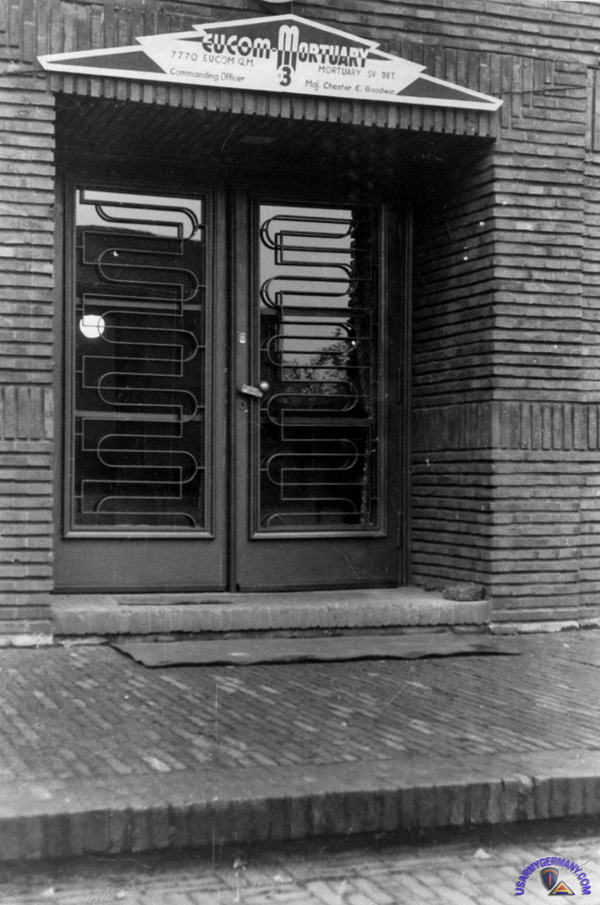 Entrance to the old Mortuary building near the Hauptfriedhof, 1952 (Brian Gibson) |
||||||||||||||||||||||||||||
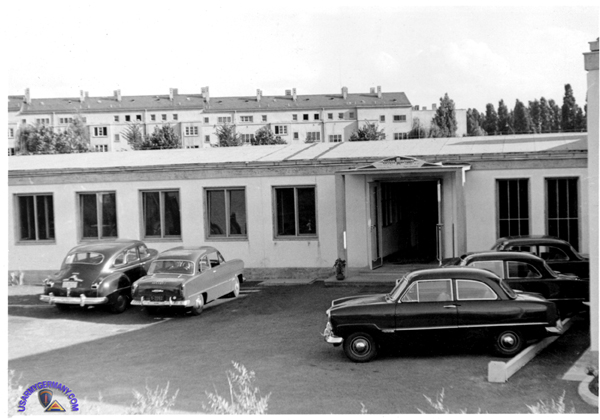 Entrance to the new Frankfurt Mortuary building, 1952 (Brian Gibson) |
||||||||||||||||||||||||||||
Nürnberg Mortuary (#2) - Westfriedhof |
||||||||||||||||||||||||||||
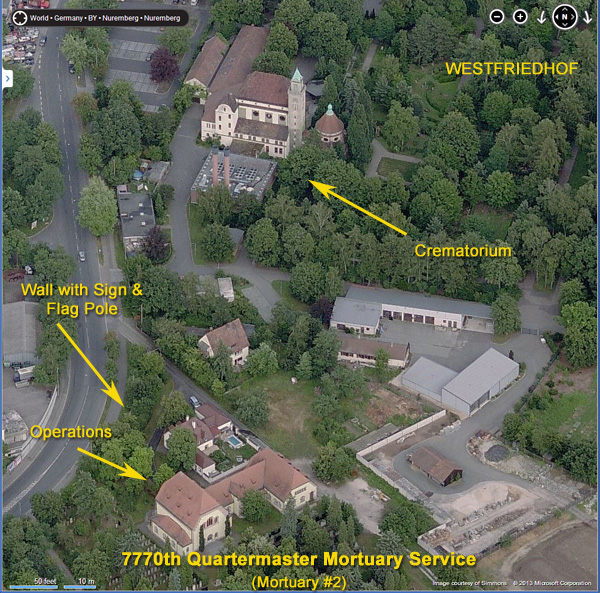 Former US Army Nürnberg Mortuary on the edge of the Westfriedhof (BING) |
||||||||||||||||||||||||||||
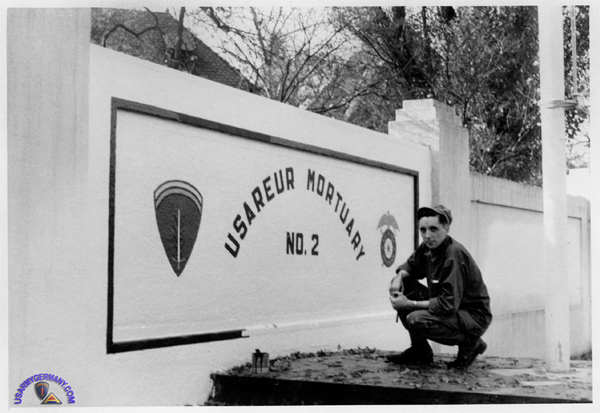 Bill Gibson takes a break while painting the USAREUR Mortuary #2 sign on a wall facing Schnieglinger Strasse in Nürnberg (Brian Gibson) |
||||||||||||||||||||||||||||
| (Source: Email from Brian Gibson, gradson of Bill Gibson, 7770th QM Mortuary Service Det, 1952-53) | ||||||||||||||||||||||||||||
| I came across your site while researching 8mm film my grandfather had shot while working and living in a mortuary in Nurnberg. He was serving in the United States Army and seems to have stayed at EUCOM Mortuary #2. There is also a photo in which he stands in front of a sign that says USAREUR MORTUARY NO. 2 I'd like to visit this mortuary if at all possible and was wondering if you might know where this particular mortuary is located within Nurnberg? If anyone has information or personal recollections of EUCOM/USAREUR Mortuary #2 in Nürnberg in the 1940s and 1950s, the webmaster would be very interested in hearing from them. |
||||||||||||||||||||||||||||
|
||||||||||||||||||||||||||||
Kaiserslautern Mortuary |
||||||||||||||||||||||||||||
|
|
||||||||||||||||||||||||||||







